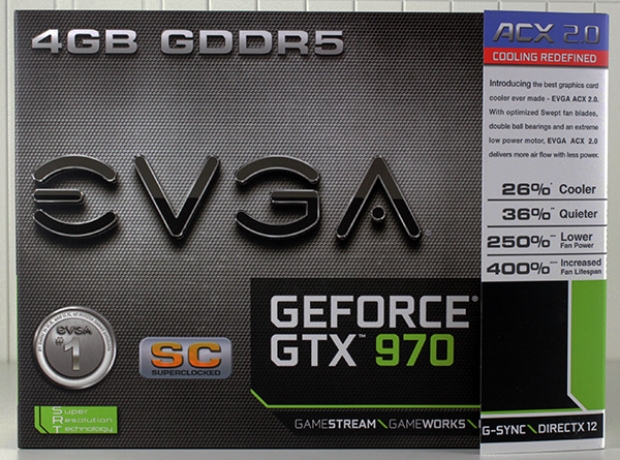Index
The Maxwell GM204 GPU proves that high-end cards do not have to end up with a huge TDP. Nvidia’s new architecture offers exceptional performance-per-watt and the GTX 970 pumps out just 145W under load.
In many tests the card can outpace the old GTX 780 with a TDP of 250W. Even the new GTX 980 does not end up much faster, so the GTX 970 may offer more value depending on your needs. With a bit of overclocking, the GTX 970 SC can match the reference GTX 980. The GTX 980 is for enthusiasts looking to buy the best single-GPU card on the market, while the GTX 970 is for value minded gamers who want the best bang for their buck.
With the GTX 970 SC ACX 2.0, EVGA has introduced a factory overclocked card capable of matching the GTX 780 Ti in some tests. Resolutions of up to 2560x1600 should not be a problem, but if you need 4K performance you will need two of these cards if you want to crank up the eye candy.
EVGA is constantly working to improve its custom components and come up with cards capable of trumping the competition. There is a range of custom cards with two different ACX 2.0 coolers. The GTX 970 SC ACX 2.0 is the cheaper of the two, while the flagship five heatpipe model is reserved for FTW cards. However, even this entry level version (if you can call it that), did not disappoint either in terms of performance or noise levels. We must note that we were distracted by the noise emitted by the card’s power components under load. Although it is audible at close range, we could not hear it once we buttoned up the chassis.
Nvidia launched three new technologies along with the GTX 980/ GTX 970. Voxel Global Illumination (VXGI) offers an efficient way of computing dynamic global illumination in real time, while MFAA can in theory deliver effects similar to 4xMSAA at a much lower computational cost.
Nvidia’s drivers are not ready yet and it is currently impossible to try out the new multi-frame antia-aliasing (MFAA) feature. Once the drivers are optimized, it is very likely that Kepler cards will lose to new Maxwell products.
Dynamic Super Resolution (DSR) provides an easy way for gamers to improve the image quality in less demanding or older games. We saw DSR in a demo and it is up to developers to harness this power in games. DSR is universal and can be applied to any game by activating it in the driver.
Since the GTX 980 and GTX 970 don’t deliver much of a performance gain, users of 780-series cards have no reason to upgrade if the only thing they want is higher performance. However, those coming from an older card do. What’s more, thanks to their efficiency, Nvidia’s new 900-series cards could even be used to upgrade gaming rigs originally based on mid-range components, with relatively weak PSUs. Our tests prove that you don’t need a massive PSU to build a high-end gaming rig with Maxwell graphics and this saves money both during the build and in the long run. Let’s not forget the somewhat lower electric bill, either.
In terms of pricing, it should be noted that the GTX 980 launches with a suggested retail price of $549, while the GTX 970 is priced at $329. EVGA GTX 970 SC ACX is priced at $349, which is only a small premium over the NVIDIA reference GTX 970 board. The premium buys you a factory overclocked card with the new ACX 2.0 cooler which unlocks even more OC potential.
Since Maxwell is Nvidia’s tenth GPU generation, EVGA is offering a promotion in honor of the new cards. For this promotion, EVGA is giving away three GTX 980 and six GTX 970 graphics cards. The Giveaway is already active and one or two cards will be handed out between September 19 and September 26. You can find more information here.




